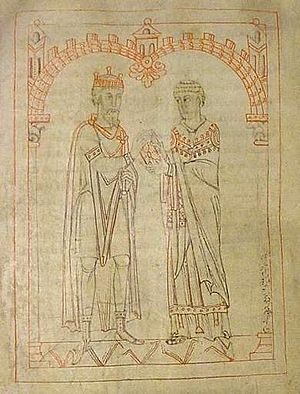Miro (Suebian king) facts for kids
Miro was a king of the Suebi people in a region called Galicia. This area is now part of modern-day Spain and Portugal. He ruled from 570 until his death in 583. During his reign, Miro worked hard to make alliances with other Christian nations. His goal was to balance the power of the Visigoths, who followed a different Christian belief. Under Miro, the Suebi kingdom became very strong. However, it collapsed just three years after he died.
Miro and the Church
King Miro had good relationships with the Church during his rule. In 572, he called for an important meeting known as the Second Council of Braga. This meeting was a follow-up to an earlier council held in 561. Some historians even think Miro himself might have represented a church area called Dumio at this council.
Miro was also very close friends with Martin of Dumio. Martin was a very important church leader, the Archbishop of Braga. He was also the main religious leader for the whole region of Gallaecia. Martin even dedicated one of his most important books, Formula Vitae Honestae, to King Miro. Another one of Martin's writings, Exhortatio Humilitatis, was probably also meant for Miro. Martin even advised Miro's helpers to read his book so they could give the king better advice.
Battles and Alliances
In the same year as the Braga council, Miro led an army against a group called the Ruccones. These people lived in Cantabria, which might have been a Basque tribe. Miro wanted to expand his kingdom by attacking them. This attack on a group within the Visigoth kingdom might have given the Visigoths a reason to fight back against the Suebi.
Conflicts with Leovigild
In 573, the Visigoth king, Leovigild, took control of a region called "Sabaria." This was probably between the cities of Zamora and Salamanca. Leovigild likely did this to stop Miro from expanding. By 574, Leovigild had brought the province of Cantabria back under his control.
Miro tried to get help from Guntram, the Frankish King of Burgundy. Guntram was often in conflict with Leovigild. However, Miro's messengers were stopped and held by Leovigild's friend, Chilperic I, another Frankish king.
In 575, Leovigild attacked the "Aregensian Mountains" near Ourense. He captured the local leader, his family, and all his wealth. This brought the region under Leovigild's power. The local leader, Aspidius, might have been a Roman landowner who had sided with the Suebi.
In 576, Leovigild marched to the southern border of Galicia. He threatened Miro's small kingdom and even built a new city called Villa Gothorum (modern Toro). Miro asked for peace, and he got it for a short time. In 580, Miro tried to support Leovigild's son, Hermenegild, who was rebelling against his father.
Miro's Death
There are different stories about how King Miro died. According to a historian named Gregory of Tours, Miro led his army to help a city called Seville in 583. Seville was being attacked by Leovigild. However, the two kings met before Miro reached Seville. Miro then returned to Galicia, where he died soon after. Gregory of Tours believed Miro died from bad air and water in the region of Baetica.
Other historians, like John of Biclar and Isidore of Seville, say that Miro died near Seville. They claim he was helping Leovigild attack the city. However, most modern historians agree with Gregory of Tours. They believe Miro would have been against Leovigild, given Miro's alliances with other kingdoms and the Suebi's dislike of the Goths. Also, Miro and the rebels shared the same Christian faith.
Miro's son, Eboric, became king of Galicia after him. Miro also left behind his wife, Sisegu(n)tia. She later married Andeca, who removed Eboric from power and became king himself.
See also
 In Spanish: Miro (rey) para niños
In Spanish: Miro (rey) para niños


